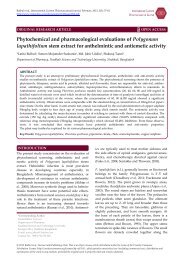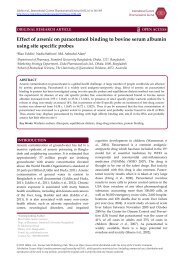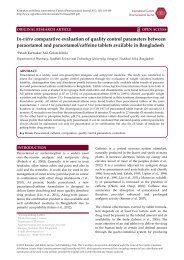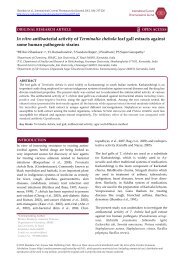Antimicrobial activity of Saponins rich fraction of Cassia auriculata ...
Antimicrobial activity of Saponins rich fraction of Cassia auriculata ...
Antimicrobial activity of Saponins rich fraction of Cassia auriculata ...
Create successful ePaper yourself
Turn your PDF publications into a flip-book with our unique Google optimized e-Paper software.
Deshpande et al., International Current Pharmaceutical Journal, March 2013, 2(4): 85-87<br />
http://www.icpjonline.com/documents/Vol2Issue4/01.pdf<br />
<strong>Antimicrobial</strong> <strong>activity</strong> <strong>of</strong> <strong>Saponins</strong> <strong>rich</strong> <strong>fraction</strong> <strong>of</strong> <strong>Cassia</strong> <strong>auriculata</strong> Linn<br />
against various microbial strains<br />
Supriya Deshpande, *Shailesh Kewatkar, Vivek Paithankar<br />
Department <strong>of</strong> Pharmaceutical Sciences, Bhagwant University, Ajmer, Rajasthan, India<br />
INTRODUCTION<br />
With the rising prevalence <strong>of</strong> microorganism<br />
showing resistance to antibiotics, there is an urgency<br />
to develop new antimicrobial compounds. Since<br />
antiquity, plants have been used to treat common<br />
infectious diseases. The healing potential <strong>of</strong> many<br />
plants have been utilized by Indian traditional<br />
medicines like Siddha, Ayurvedha and Unani. Being<br />
nontoxic and easily affordable, there has been<br />
resurgence in the consumption and demand for<br />
medicinal plants (Jayashree and Maneemegalai,<br />
2008). <strong>Cassia</strong> <strong>auriculata</strong> L. commonly known as<br />
tanners cassia, also known as “avaram” in Tamil<br />
language is a shrub belongs to the Caesalpiniaceae<br />
family. The shrub is especially famous for its<br />
attractive yellow flowers which are used in the<br />
treatment <strong>of</strong> skin disorders and body odour. It is<br />
widely used in traditional medicine for rheumatism,<br />
conjunctivitis and diabetes. It has many medicinal<br />
properties. Its bark is used as an astringent, leaves<br />
and fruits anthelminthic, seeds used to treat in eye<br />
troubles and root employed in skin diseases (Siva<br />
International Current<br />
Pharmaceutical Journal<br />
ORIGINAL RESEARCH ARTICLE OPEN ACCESS<br />
ABSTRACT<br />
In the present investigation, the saponins <strong>rich</strong> <strong>fraction</strong> <strong>of</strong> roots <strong>of</strong> <strong>Cassia</strong> <strong>auriculata</strong> L. was evaluated for antimicrobial<br />
<strong>activity</strong> against P. vesicularis, Streptococcus faecalis, Aeromonas hydrophilia, Salmonella typhae, Staphylococcus cohni, Serratia<br />
ficaria and E. coli at concentration <strong>of</strong> 12.5 mg/ml, 25 mg/ml, 37.5 mg/ml and 50 mg/ml. <strong>Antimicrobial</strong> <strong>activity</strong> <strong>of</strong> <strong>Cassia</strong><br />
<strong>auriculata</strong> L. was carried out by well diffusion method. At maximum conc i.e. 50 mg/ml antimicrobial effect <strong>of</strong> Saponin<br />
<strong>rich</strong> extract can be arranged in sequence <strong>of</strong> - P. vesicularis > Serratia ficaria > Streptococcus cohni > Aeromonas hydrophilic>,<br />
Salmonella typhae > Sterptococcus faecalis > E. coli. The results indicate the saponins <strong>rich</strong> <strong>fraction</strong> <strong>of</strong> roots <strong>of</strong> <strong>Cassia</strong><br />
<strong>auriculata</strong> L. might be exploited as natural drug for the treatment <strong>of</strong> several infectious diseases caused by these<br />
organisms. <strong>Cassia</strong> <strong>auriculata</strong> L. was observed to have antibacterial <strong>activity</strong> and can be used for medicinal purposes.<br />
Key Words: Infectious diseases, ayurveda, indian traditional medicines, caesalpiniaceae, well diffusion method, pathogens.<br />
*Corresponding Author:<br />
Shailesh Kewatkar (M. Pharm)<br />
Department <strong>of</strong> Pharmaceutical Sciences<br />
Bhagwant University, Ajmer<br />
Rajasthan, India<br />
E-mail: kewatkar.shailesh@gmail.com<br />
Contact No.: 09303649756<br />
and Krishnamurthy, 2005). It is also used for the<br />
treatment <strong>of</strong> ulcers, leprosy and liver disease<br />
(Kumar et al., 2002). The antidiabetic, hypolipidemic<br />
(Umadevi et al., 2006) and antioxidant (Kumaran<br />
and Karunakaran, 2007) and hepatoprotective<br />
(Kumar et al., 2003) effect <strong>of</strong> <strong>Cassia</strong> <strong>auriculata</strong> L. have<br />
been reported. It was also observed that flower and<br />
leaf extract <strong>of</strong> <strong>Cassia</strong> <strong>auriculata</strong> L. shown to have<br />
antipyretic <strong>activity</strong> (Vedavathy and Rao, 1991). The<br />
aim <strong>of</strong> the present study was to determine the<br />
antibacterial <strong>activity</strong> <strong>of</strong> various extracts <strong>of</strong> <strong>Cassia</strong><br />
<strong>auriculata</strong> L. flowers which is having traditional<br />
claims for several diseases Because <strong>of</strong> the close<br />
morphological similarity, non-availability <strong>of</strong><br />
scientific parameters to identify the true plant<br />
material and to ensure its quality, the present work<br />
has been undertaken to establish the antimicrobial<br />
potential <strong>of</strong> the plant, which could serve as a<br />
measure <strong>of</strong> selection <strong>of</strong> <strong>Cassia</strong> <strong>auriculata</strong> Linn. for the<br />
treatment <strong>of</strong> various diseases.<br />
MATERIALS AND METHODS<br />
Procurement and authentication <strong>of</strong> plant<br />
The root <strong>of</strong> the plant <strong>Cassia</strong> <strong>auriculata</strong> L. was collected<br />
from fields <strong>of</strong> Walgaon Road, Amravati,<br />
Maharashtra and interiors <strong>of</strong> Bhopal, Madhya<br />
Pradesh respectively. The plant has been authenti-<br />
© 2013 Deshpande et al.; licensee Saki Publishing Club. This is an Open Access article distributed under the terms <strong>of</strong> the Creative Commons<br />
Attribution License (http://creativecommons.org/licenses/by-nd/3.0/), which permits unrestricted use (including commercial use), distribution and<br />
reproduction <strong>of</strong> the work in any medium, provided the original work is properly cited and remain unaltered.
cated by Safia College <strong>of</strong> Science, Peer Gate, Bhopal,<br />
(Madhya Pradesh), and were given the voucher<br />
specimen number 159/Bot/Safia/2010. The authenticated<br />
roots were dried under shade and then coarsely<br />
powdered with the help <strong>of</strong> mechanical grinder. The<br />
powdered was passed through sieve no. 40 and<br />
stored in an airtight container for extraction.<br />
Preparation <strong>of</strong> saponins <strong>rich</strong> <strong>fraction</strong><br />
Roots <strong>of</strong> the plant were collected and dried. Pulverized<br />
plant material (roots <strong>of</strong> <strong>Cassia</strong> <strong>auriculata</strong> Linn.)<br />
was treated with ethanol: water (70:30) for maceration<br />
till seven days after defatting with petroleum<br />
ether (40:60). Mixture was agitated at regular<br />
interval in this period. Obtained extract after<br />
filtration with muslin cloth followed by filter paper<br />
was concentrated using rotary vacuum evaporator<br />
(40°C), precaution was kept that extract do not get<br />
powdered. Concentrated extract was further treated<br />
with n-butanol to get n-butanol soluble <strong>fraction</strong>. nbutanol<br />
soluble <strong>fraction</strong> was further treated with<br />
chilled diethyl ether. After treating with chilled<br />
diethyl ether, precipitates were formed. This<br />
mixture with precipitate was kept at -20°C for 24<br />
hrs. Precipitates were further separated by centrifugation.<br />
These precipitate were further dissolved in<br />
methanol and methanol was evaporated slowly, to<br />
get crystalline powder (Aliyu et al., 2011; Cibin et al.,<br />
2006; Cabrini et al., 2008)<br />
<strong>Antimicrobial</strong> <strong>activity</strong> <strong>of</strong> extract<br />
Stock solution sample was prepared (1mg /ml) then<br />
the dilution dilutions <strong>of</strong> 50%, 37.5%, 25% and 12.5%<br />
were prepared. Wells <strong>of</strong> 6mm was prepared using a<br />
sterile cork borer. Bacterial culture were grown<br />
using sterile cotton swab method. Then the plates<br />
were inoculated and 80 µl <strong>of</strong> each dilution sample<br />
was poured in respected wells and plates were<br />
incubated for 16- 18 hrs at 37°C. After 16 to 18 hours<br />
<strong>of</strong> incubation, each plate was examined. The<br />
diameters <strong>of</strong> the zones <strong>of</strong> complete inhibition are<br />
measured, including the diameter <strong>of</strong> the disc (Bansal<br />
and Bansal, 2010; Jain, 2005).<br />
RESULTS AND DISCUSSION<br />
<strong>Antimicrobial</strong> <strong>activity</strong> <strong>of</strong> saponins <strong>rich</strong> <strong>fraction</strong> <strong>of</strong><br />
<strong>Cassia</strong> <strong>auriculata</strong> L. root was investigated against P.<br />
vesicularis, Streptococcus faecalis, Aeromonas hydrophilia,<br />
Salmonella typhae, Staphylococcus cohni, Serratia<br />
Figure 1: <strong>Antimicrobial</strong> <strong>activity</strong> <strong>of</strong> <strong>Cassia</strong> <strong>auriculata</strong><br />
Linn. saponins <strong>rich</strong> <strong>fraction</strong>.<br />
ficaria and E. coli at concentrations <strong>of</strong> 12.5 mg/ml, 25<br />
mg/ml, 37.5 mg/ml and 50 mg/ml. <strong>Antimicrobial</strong><br />
effect was ascertained on the basis <strong>of</strong> zone <strong>of</strong><br />
inhibition.<br />
Saponin <strong>rich</strong> extract <strong>of</strong> <strong>Cassia</strong> <strong>auriculata</strong> L. showed<br />
best antimicrobial <strong>activity</strong> against P. vesicularis and<br />
least against E. coli at 50 mg/ml. At 12.5 mg/ml zone<br />
<strong>of</strong> inhibition for P. vesicularis was 14.25±2.04 mm<br />
which was significantly higher (P Streptococcus cohni> Aeromonas hydrophili><br />
Salmonella typhae> Sterptococcus faecalis> E. coli.<br />
<strong>Saponins</strong> are glycosides <strong>of</strong> triterpenes, steroids or<br />
steroidal alkaloids; they are regarded as natural<br />
antimicrobial compounds with very diverse biological<br />
activities whose roles in food, animal feed stuffs<br />
and pharmaceutical applications have been useful to<br />
man. <strong>Saponins</strong> have been implicated as bioactive<br />
antibacterial agents <strong>of</strong> plants containing them.<br />
Another study indicates the antibacterial sensitivity<br />
<strong>of</strong> saponins more on gram negative than gram<br />
86
positive. Although variations in the chemical nature<br />
<strong>of</strong> the saponins from different plants reported in the<br />
literature, may perhaps explain the variation in<br />
<strong>activity</strong> against various pathogens. Saponin compounds<br />
in plant are believed to naturally protect it<br />
against attack from pathogens, which would<br />
account for their antimicrobial <strong>activity</strong>. The mode <strong>of</strong><br />
action <strong>of</strong> antibacterial effects <strong>of</strong> saponins may<br />
involve membranolytic properties, rather than<br />
simply altering the surface tension <strong>of</strong> the extracellular<br />
medium (Aliyu et al., 2011).<br />
CONCLUSION<br />
The present study exhibited the antimicrobial effect<br />
<strong>of</strong> saponins <strong>rich</strong> <strong>fraction</strong> <strong>of</strong> roots <strong>of</strong> <strong>Cassia</strong> <strong>auriculata</strong><br />
L. The inhibitory effect <strong>of</strong> the extract justified the<br />
medicinal use <strong>of</strong> <strong>Cassia</strong> <strong>auriculata</strong> L. and further<br />
study is required to find out the active component<br />
<strong>of</strong> medicinal value.<br />
ACKNOWLEDGEMENTS<br />
ACKNOWLEDGEMENT<br />
Authors are thankful to Mr. Manvendra Singh<br />
Karchuli (Research Associate) and Director, Safia<br />
College <strong>of</strong> Science, Bhopal for their support and<br />
help for the completion <strong>of</strong> this research work.<br />
REFERENCES<br />
REFERENCES<br />
Aliyu, AB., Musa, AM., Abdullahi, MS., Ibrahim, MA., Tijjani,<br />
MB., Aliyu, MS. and Oyewale AO. (2011) Activity <strong>of</strong><br />
saponin <strong>fraction</strong> <strong>of</strong> Anisopus mannii against some pathogenic<br />
microorganisms. Journal <strong>of</strong> Medicinal Plants<br />
Research, Volume 5, Issue 31, Pages 6709-6713.<br />
Bansal, R and Bansal M. (2010) Pharmaceutical microbiology,<br />
Volume 1, Pages 199-216.<br />
Cabrini, DA., Castardo, JC., Prudente, AS., Ferreira, J.,<br />
Guimaraes, CL., Monache FD., Filho VC. And Otukia MF.<br />
(2008) Anti-inflammatory effects <strong>of</strong> hydroalcoholic extract<br />
and two biflavonoids from Garcinia gardneriana leaves in<br />
mouse paw oedema. Journal <strong>of</strong> Ethnopharmacology, Issue<br />
118, Pages 405–411. [DOI]<br />
Cibin, TR., Srinivas, G., Gayathri, Devi G., Srinivas, P., Lija, Y.<br />
and Abraham, A. (2006) Antioxidant and antioproliferative<br />
effect <strong>of</strong> flavonoids from Emilia sonchifolia Linn. On<br />
human cancer cells. International journal <strong>of</strong> pharmacology,<br />
Volume 2, Pages 520-524.<br />
Jain, NK., (2005). Pharmaceutical microbiology Volume 2,<br />
Pages 294-305.<br />
Jayashree, A. and Maneemegalai S. (2008) Studies on the<br />
antibacterial <strong>activity</strong> <strong>of</strong> the extracts from Tridax procumbens<br />
L and Ixora coccinea L. Biomedicine, Volume 28, Pages 190-<br />
194.<br />
Kumar, RS., Ponmozhi, M. and Nalini M. (2002) Effect <strong>of</strong><br />
<strong>Cassia</strong> <strong>auriculata</strong> leaf extract on lipids in rats with alcoholic<br />
liver injury. Asia Pacific J <strong>of</strong> Clinical Nutrition, Volume 11,<br />
Pages 157-163. [DOI]<br />
Kumar, RS., Ponmozhi, M., Viswanathan, P. and Nalini, N.<br />
(2003) Activity <strong>of</strong> <strong>Cassia</strong> <strong>auriculata</strong> leaf extract in rats with<br />
alcoholic liver injury. J <strong>of</strong> Nutritional Biochemistry, Volume<br />
14, Pages 452-458.<br />
Kumaran, A. and Karunakaran, R.J. (2007) Antioxidant<br />
<strong>activity</strong> <strong>of</strong> <strong>Cassia</strong> <strong>auriculata</strong> flowers. Fitoterapia, Issue 78,<br />
Pages 46-47. [DOI]<br />
Siva, R. and Krishnamurthy, KV. (2005) Isozyme diversity in<br />
<strong>Cassia</strong> <strong>auriculata</strong> L. African J <strong>of</strong> Biotechnology, Volume 4,<br />
Pages 772-775.<br />
Umadevi, P., Selvi, S., Suja, S., Selvam, K., Chinnaswamy, P.<br />
(2006) Antidiabetic and hypolipidemic effect <strong>of</strong> <strong>Cassia</strong><br />
<strong>auriculata</strong> in alloxan induced diabetic rats. International J<br />
<strong>of</strong> Pharmacology, Volume 2, Pages 601-607.<br />
Vedavathy, S. and Rao, KN. (1991) Antipyretic <strong>activity</strong> <strong>of</strong> six<br />
indigenous medicinal plants <strong>of</strong> Tirumala hills. J <strong>of</strong> Ethanopharmacology<br />
Issue 33, Pages 193-196. [DOI]<br />
87









